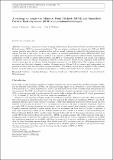A strategy to couple the material point method (MPM) and smoothed particle hydrodynamics (SPH) computational techniques
Author(s)
Jones, Bruce David; Raymond, Samuel James; Williams, John R
Download40571_2016_149_ReferencePDF.pdf (761.2Kb)
OPEN_ACCESS_POLICY
Open Access Policy
Creative Commons Attribution-Noncommercial-Share Alike
Terms of use
Metadata
Show full item recordAbstract
A strategy is introduced to allow coupling of the material point method (MPM) and smoothed particle hydrodynamics (SPH) for numerical simulations. This new strategy partitions the domain into SPH and MPM regions, particles carry all state variables and as such no special treatment is required for the transition between regions. The aim of this work is to derive and validate the coupling methodology between MPM and SPH. Such coupling allows for general boundary conditions to be used in an SPH simulation without further augmentation. Additionally, as SPH is a purely particle method, and MPM is a combination of particles and a mesh. This coupling also permits a smooth transition from particle methods to mesh methods, where further coupling to mesh methods could in future provide an effective farfield boundary treatment for the SPH method. The coupling technique is introduced and described alongside a number of simulations in 1D and 2D to validate and contextualize the potential of using these two methods in a single simulation. The strategy shown here is capable of fully coupling the two methods without any complicated algorithms to transform information from one method to another.
Date issued
2016-12Department
Massachusetts Institute of Technology. Department of Civil and Environmental Engineering; Massachusetts Institute of Technology. Institute for Data, Systems, and SocietyJournal
Computational Particle Mechanics
Publisher
Springer International Publishing
Citation
Raymond, Samuel J., Bruce Jones, and John R. Williams. “A Strategy to Couple the Material Point Method (MPM) and Smoothed Particle Hydrodynamics (SPH) Computational Techniques.” Computational Particle Mechanics 5, no. 1 (December 10, 2016): 49–58.
Version: Author's final manuscript
ISSN
2196-4378
2196-4386